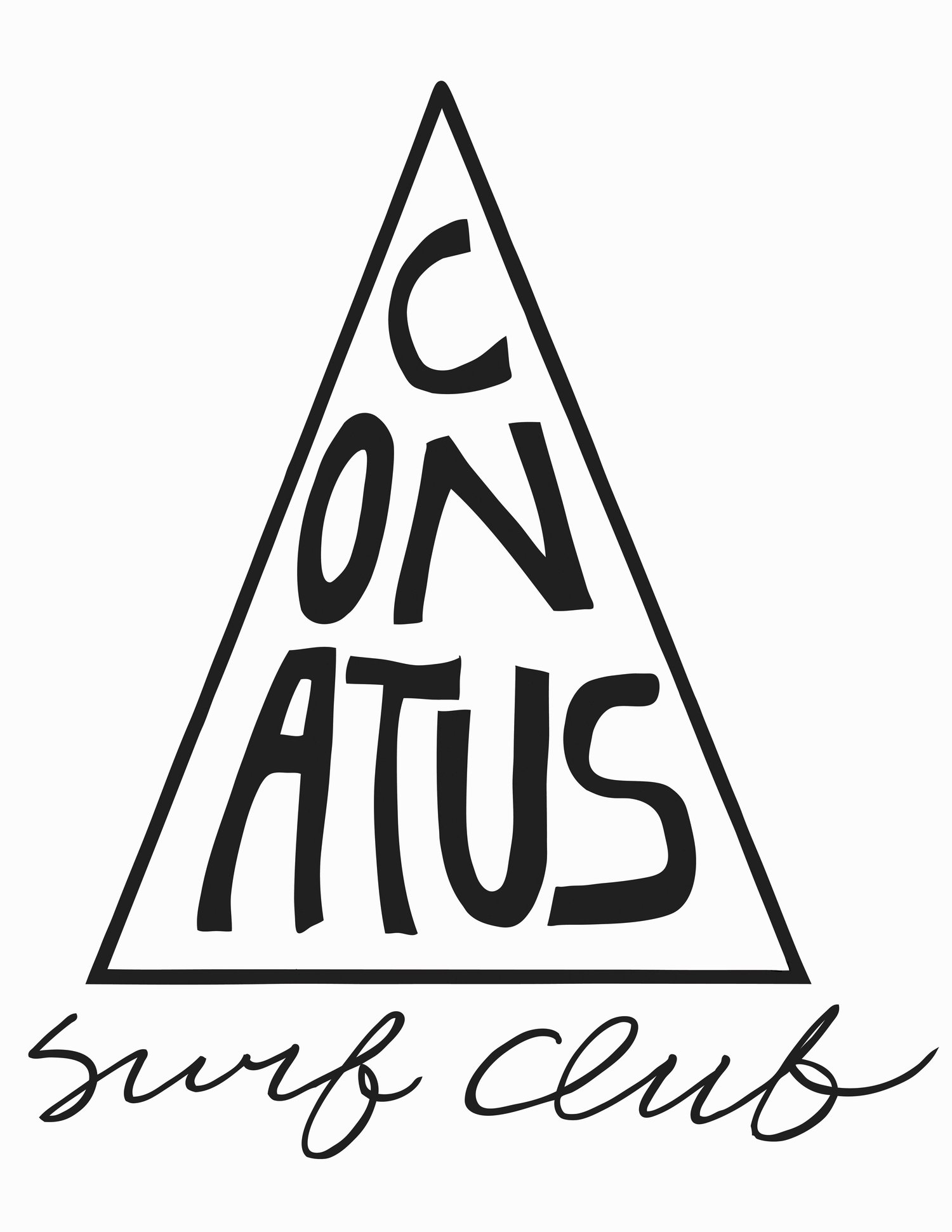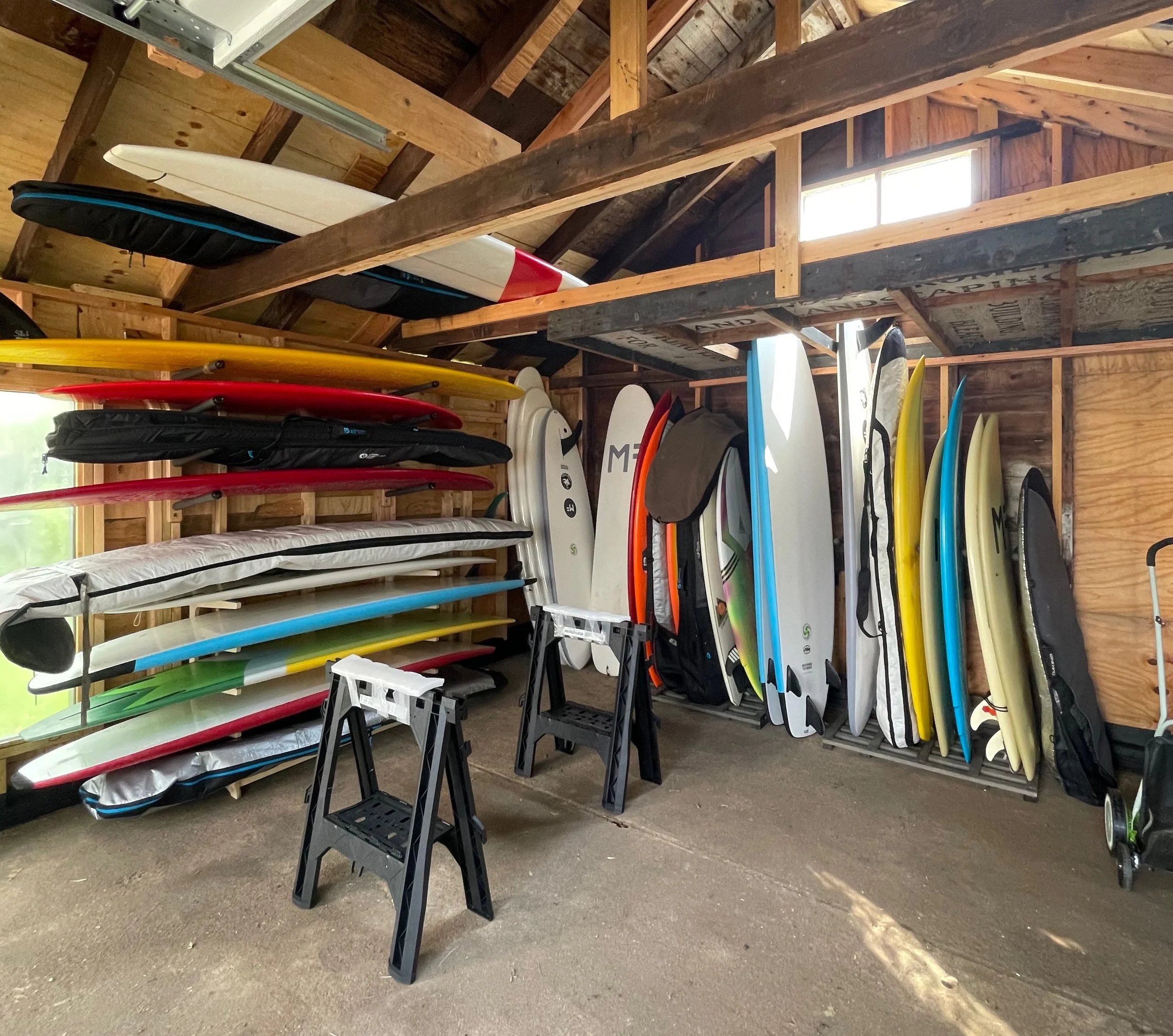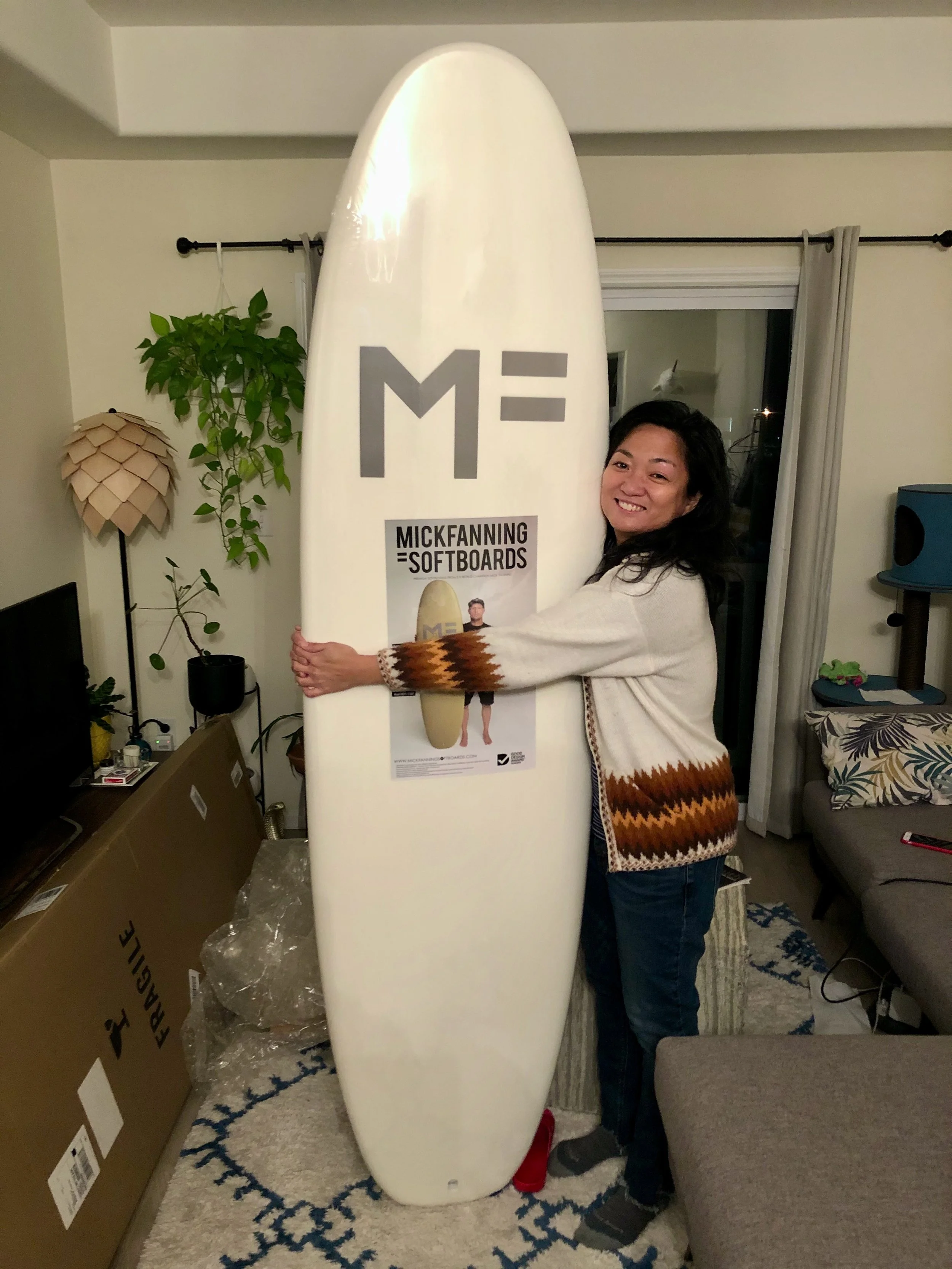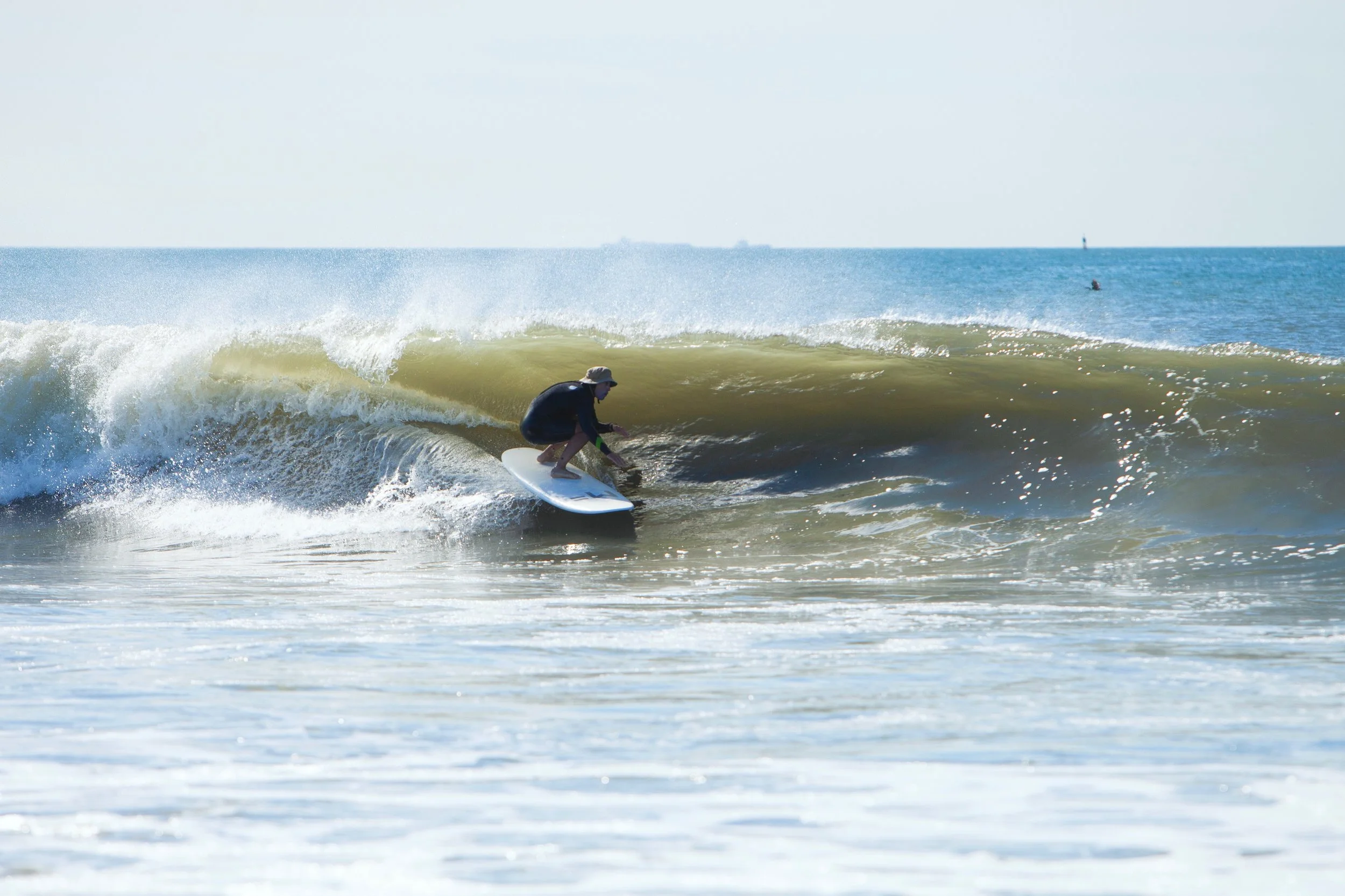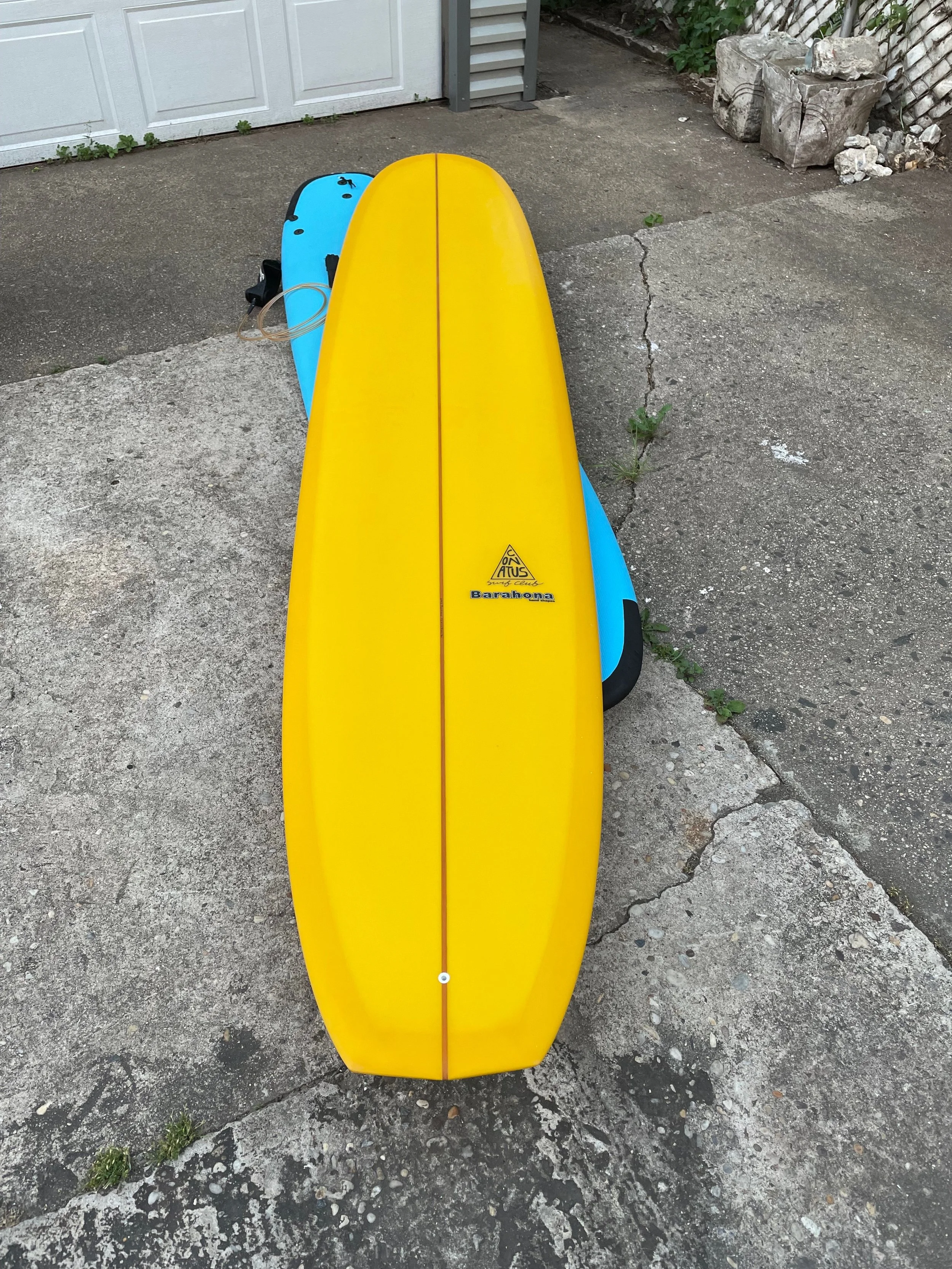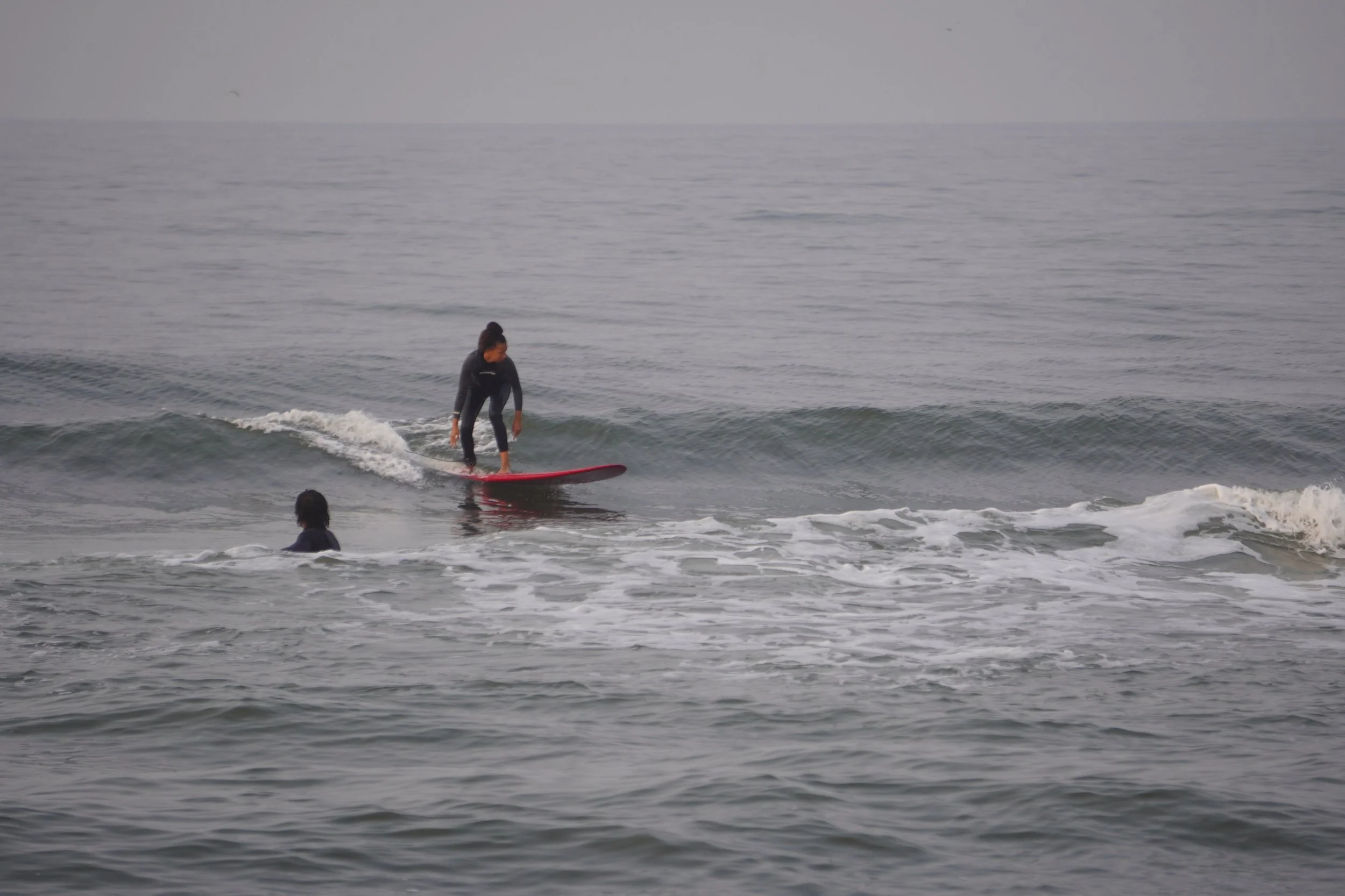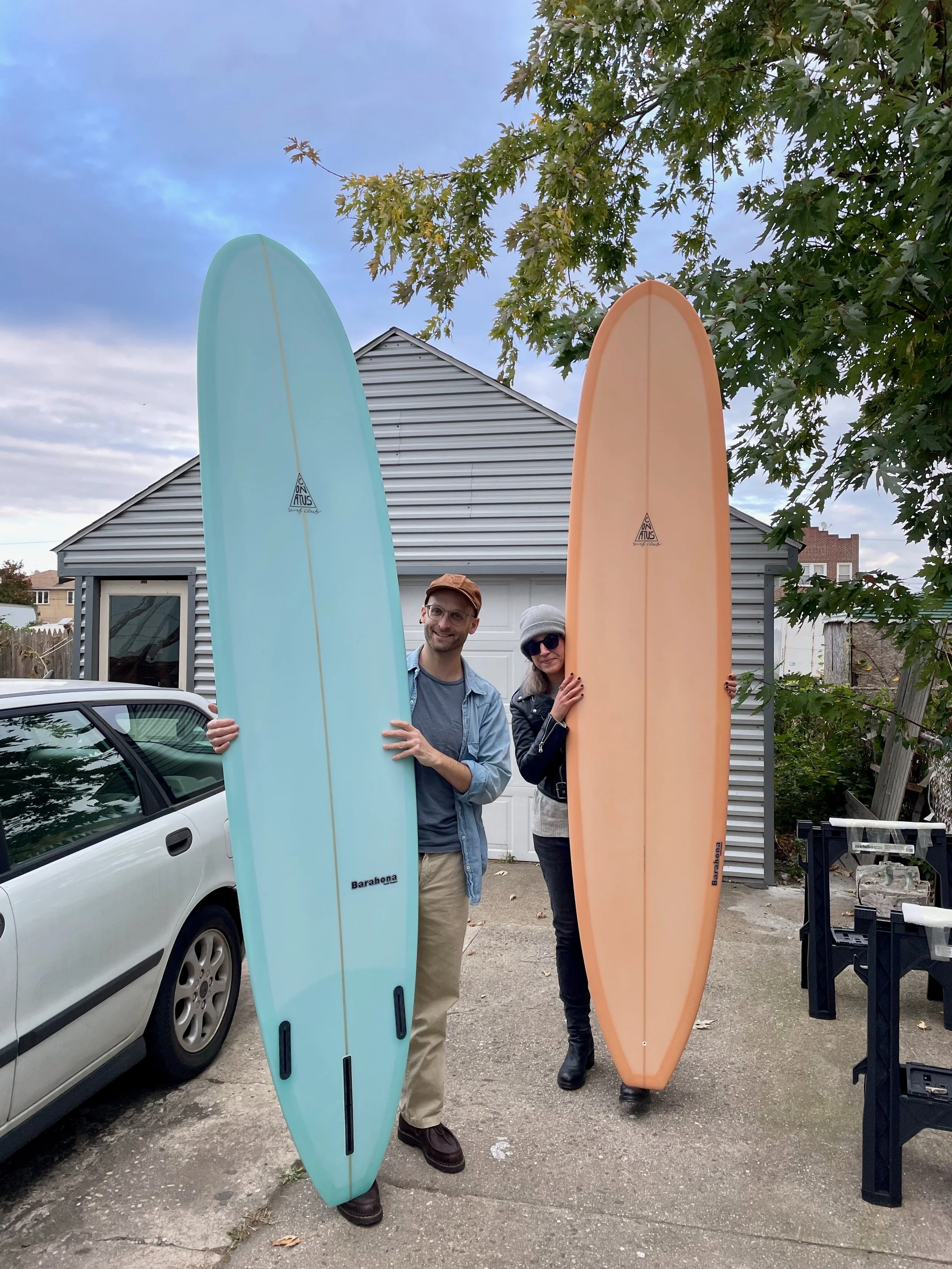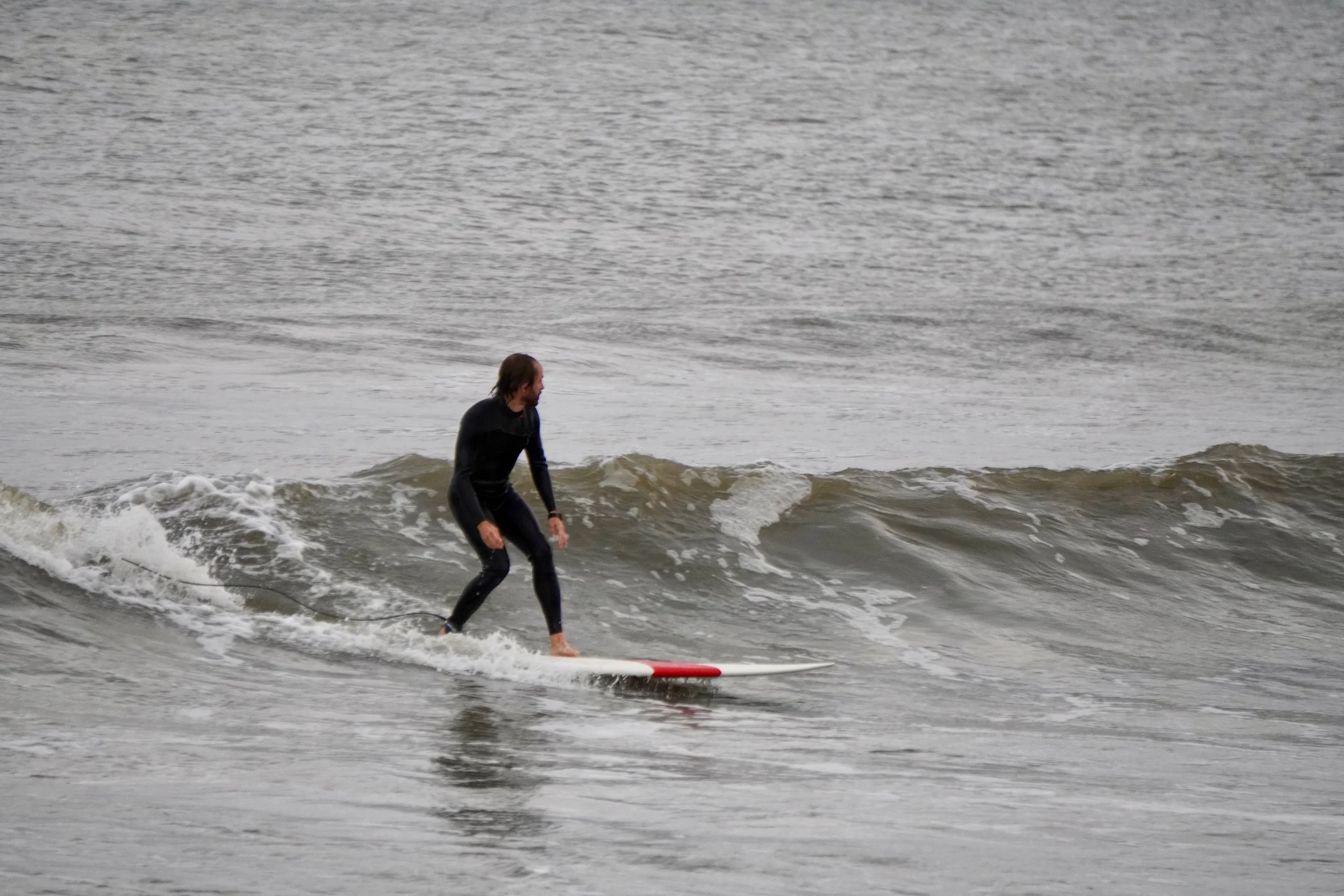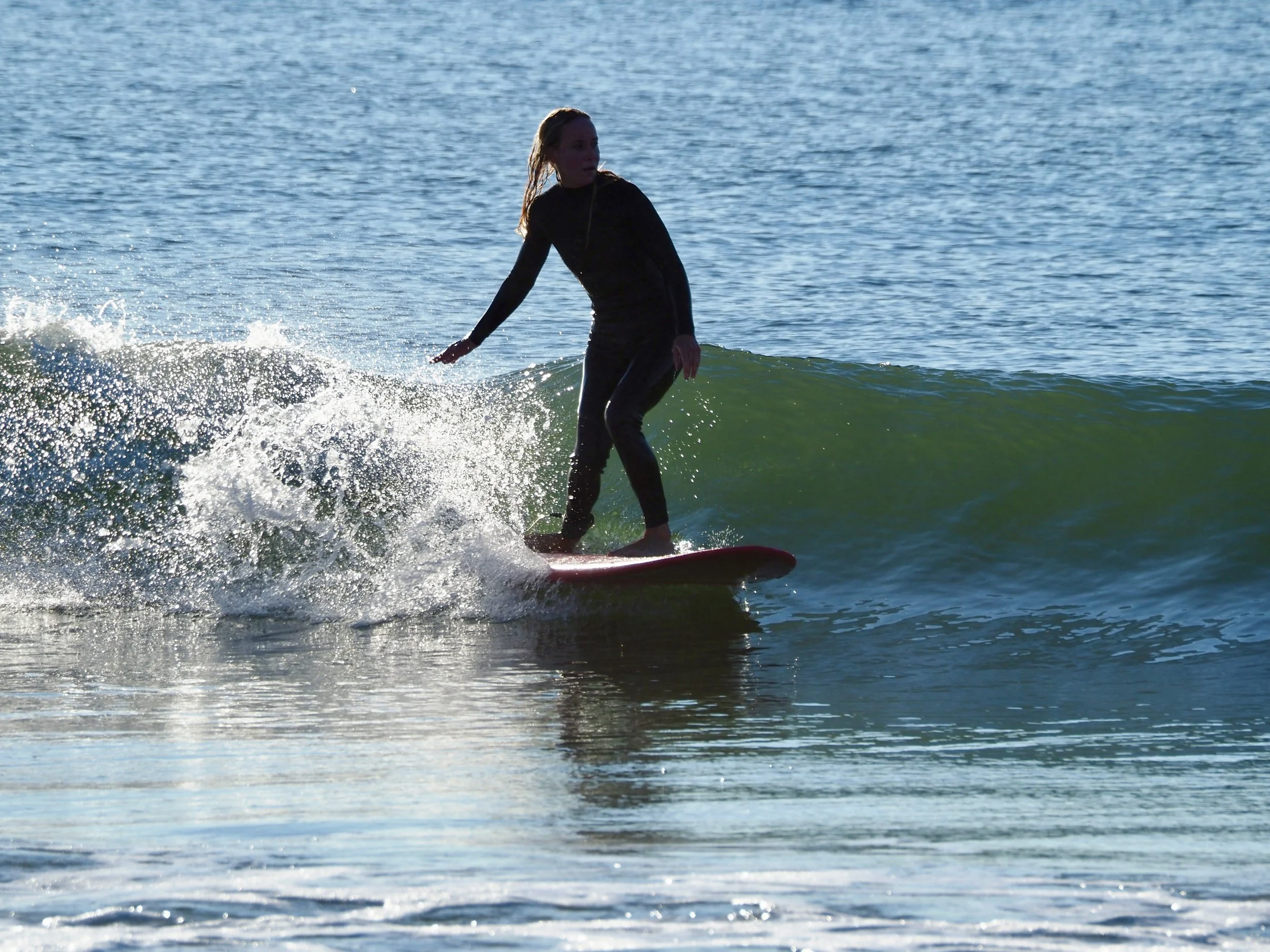Most surf shops will tell you that any beginner board will do as long as it's "big and soft." This is completely wrong. The reality? Pick the wrong board, and you risk spending hundreds of dollars on something that holds you back, makes learning harder, and kills your confidence before you ever catch a wave.
The truth is that the right board can fast-track your progress. The wrong one can leave you frustrated and stuck on the beach. After coaching hundreds of beginners and testing equipment across multiple continents, I've identified the exact specifications and decision frameworks that separate boards that accelerate learning from those that impede it.
This guide will help you avoid the common traps and choose a board that sets you up to actually enjoy learning to surf.
What You'll Learn in This Surfboard Buying Guide
Own vs. Rent Decision - When board ownership becomes essential for your surfing progression
Soft vs. Hard Construction - Performance characteristics, safety considerations, and manufacturing quality differences between soft tops and traditional hard boards
Budget Planning - Realistic price ranges for quality equipment and brands to avoid
Sizing Specifications - Exact dimensions for optimal beginner boards based on weight and skill level
Technical Features - Rail configurations, rocker requirements, and fin setups that accelerate learning
Practical Logistics - Storage solutions, transport techniques, and board care essentials
Travel Considerations - When to graduate from renting to traveling with your own equipment
Custom Board Options - Working with shapers for precisely tailored equipment that grows with your progression
Own or Rent?
Board ownership becomes essential once you commit to consistent local practice. If you are certain that surfing will be a lifelong pursuit, owning your own surfboard eliminates dependencies on rental availability and timing constraints at your local break. Ownership enables spontaneous sessions and develops familiarity with your equipment's handling characteristics.
Travel considerations require separate analysis. I address the decision matrix for traveling with your own equipment versus renting at destinations later in this guide. Each approach presents distinct advantages and limitations, particularly for beginners requiring larger, more stable boards.
Best First Surfboard: Soft Surfboard or Hard Surfboard?
The fundamental choice between soft and hard construction demands careful consideration of multiple factors. I reject the assumption that all beginners should default to soft tops, as both options offer legitimate advantages depending on individual circumstances and priorities.
Soft Surfboard: Ideal for beginners who want a safer, more forgiving board that makes learning easier and reduces the risk of injury or dings.
Hard Surfboard: Best for committed beginners who want faster skill development, better performance, and the traditional surfing experience.
What Is a Soft Surfboard?
Ruth with her MF Beastie model.
A soft surfboard (or soft top) is a surfboard with a soft foam deck instead of a hard fiberglass or epoxy surface. It's designed to be more forgiving, both for the rider and anyone nearby in the water.
Key Features of Soft Surfboards:
Foam top: Cushioned and grippy, reducing the risk of injury
Plastic bottom: Durable and smooth enough to glide on waves
Rounded rails: More stable, less responsive
More volume: Easier to paddle and balance on
Why Choose a Soft Surfboard
Premium soft tops offer injury reduction and ding resistance without sacrificing performance. Soft surfboard quality varies dramatically across manufacturers. Premium soft tops provide injury reduction and ding resistance while maintaining performance characteristics. However, soft tops do not eliminate injury risk entirely. I emphasize that soft construction never excuses poor board control or inadequate water safety practices—it merely provides additional margin for error during the inevitable learning mistakes.
The "soul" debate surrounding soft tops reflects misguided purism. Critics arguing that soft tops lack authenticity apply arbitrary standards to industrial products. Whether polyurethane foam or tree-derived materials possess inherent "soul" is philosophically meaningless. Board soul manifests through the surfer's developing style, ocean respect, and consideration for other water users. Technical construction methods are irrelevant to these essential qualities.
No soul on a soft top? Soul is just a relaxed posture and an understanding of the wave! Here I am on an MF 7’0”.
Premium soft top manufacturers—Mick Fanning, Surf Tech, and Surf Crime—produce boards with sufficient rigidity and solid fin systems. These brands manufacture in Asia due to production economics, raising potential ethical considerations regarding labor practices and environmental impact. Currently, no significant soft top production occurs in the United States, Australia, or Europe.
Quality soft tops with appropriate rigidity perform admirably. I ride these boards regularly and find them genuinely enjoyable. The primary practical advantage remains reduced ding susceptibility during transport—the most common source of board damage for recreational surfers.
What Is a Hard Surfboard?
A classic Barahona log with a diamond tail.
A hard surfboard has a rigid outer shell made from fiberglass or epoxy cloth and resin over a polystyrene or polyurethane foam core. These are the traditional boards most experienced surfers use.
Key Features:
Hard outer shell: Smooth, fast, and responsive
Rigid construction: Less forgiving than soft tops but provides superior performance
Sharpened rails: Allow for tighter turns and better maneuverability
Variety of shapes: From shortboards to longboards, each built for specific styles of surfing
Why Choose a Hard Surfboard
Claudia feeling the glide on a hard, fiberglass surfboard.
Traditional hard surfboards offer superior performance and responsiveness, accelerating skill development for committed surfers who prioritize progression.
Hard surfboards offer distinct advantages for committed beginners. These boards are typically constructed with either polyurethane (PU) or polystyrene foam blanks, wrapped in fiberglass or epoxy cloth, and coated with polyurethane or epoxy resin that goes on wet and dries hard. While I have a separate video addressing the differences between epoxy and PU construction, both represent what we consider traditional hard surfboard construction.
Hard surfboards provide superior water feel when properly sized for your skill level and body weight. Polyurethane boards particularly excel at sitting naturally in the water, offering enhanced glide characteristics. More importantly, hard surfboards demand immediate development of proper board control—there is no margin for error. This higher stakes environment accelerates skill acquisition.
I previously advocated exclusively for hard surfboards, reasoning that since intermediate and advanced surfers ride hard surfboards, beginners should develop superior board control from the outset rather than transitioning later. Hard surfboards also command greater respect due to their potential for injury, which naturally elevates safety awareness and board handling skills.
Beyond performance considerations, hard surfboards offer aesthetic and customization advantages. They provide the traditional surfing experience—applying wax, custom colors, personalized stringers. For those ordering custom boards through shapers like Jose Barajona and myself, the board becomes uniquely tailored to your progression and personal style.
Hard surfboard options include secondhand boards, off-the-rack shapes (hand-shaped versus machine-shaped), and custom orders. Avoid pop-out constructions like Torq boards, which are machine-cut from molds in Asia. While cheaper, these boards lack authentic surf industry craftsmanship and offer neither the safety benefits of soft tops nor the performance advantages of traditional hard surfboards. They occupy an uncomfortable middle ground.
Custom boards deserve particular consideration. Many beginners assume they're "not good enough" for custom work, but properly fitted boards accelerate progress significantly. When working with experienced coaches, custom boards can be precisely tailored to your current skill level and local conditions.
Surfboard Budget and Sizing Considerations
Budget constraints necessarily influence board selection. Quality used soft surfboards range from $400 to $800 maximum, with premium Surf Crime and Surf Tech models approaching the upper limit. Avoid budget brands like Liquid Shredder and Catch Surf—their thick rails lack sensitivity and resist rail engagement, forcing boards toward straight-line trajectories that impede progression.
Hard surfboard pricing spans wider ranges: used boards cost between $250 and $1200. Avoid premium vintage longboards in favor of modern longboards with appropriate rocker characteristics for beginning surfers.
Sizing requires expert consultation rather than reliance on volume calculations. The fundamental requirement is adequate flotation. The most common error involves choosing undersized boards for easier transport. However, inadequate flotation prevents effective paddling development, which stalls overall progression. Paddling technique can only be perfected with sufficient board volume.
The optimal beginner board measures 8'6" by 23" by 3"—a modern longboard with 2+1 fin configuration (single fin with two side bite boxes). This specification suits riders weighing between 140 and 185 pounds.
Heavier riders (185 pounds and above) require 9 to 10-foot boards. Additional length provides necessary volume without requiring increased width or thickness, though slight adjustments to 23.5" wide or 3.5" thick remain acceptable.
Lighter riders may use 8' by 22.5" boards while maintaining 3" thickness. Avoid reducing thickness during early progression stages.
Critical design elements include 60/40 rail configuration rather than 50/50 rails, and sufficient rocker to prevent pearling. Modern longboards incorporate traditional longboard outlines with increased nose and tail rocker, providing forgiveness for developing surfers. Flat boards with minimal rocker offer excellent glide for experts but prove problematic for beginners lacking refined board control.
Practical Surfboard Considerations
Storage and transport logistics must accommodate board size requirements. Urban environments like New York often necessitate external storage solutions due to apartment space constraints. I operate a clubhouse facility for gear storage and rental specifically addressing this urban challenge.
Minimum protection requires soft board bags for ding prevention. Post-session rinsing prevents salt crystal accumulation but remains optional. However, sand removal is essential—rinse boards in the shorebreak before leaving the beach to prevent sand contamination in vehicles and homes.
Large beginner boards require specific carrying techniques. The underarm carry proves impossible due to necessary board width for stability. Alternative methods include hip carries using the "laundry bag" technique or overhead carries. Some manufacturers like Mick Fanning incorporate center handles on surf school models. Surfboard bags with shoulder straps provide additional transport options for those prioritizing carrying ease while maintaining appropriate board dimensions.
Travel Considerations
Traveling with 9-foot beginner boards presents significant logistical challenges. However, board familiarity offers substantial advantages: consistent equipment eliminates variables and enables continued progression on known handling characteristics rather than adapting to unfamiliar rental equipment.
Logistical requirements include appropriate strapping systems—basic car straps rather than full soft rack systems—for securing boards to various vehicle types. Many destinations accommodate larger vehicles including minivans and SUVs.
Airline policies vary significantly by carrier and destination. California flights often waive board fees due to surfing's state sport status. JetBlue treats boards as standard checked luggage for certain destinations. Research carrier-specific policies and avoid declaring "surfboard" transport—instead, pay standard extra bag fees when possible.
Airline damage risk represents the primary downside of board travel. This risk must be weighed against the benefits of equipment familiarity and continued progression.
Skill level determines travel equipment recommendations. Total beginners may rent at destinations with adequate board availability. However, advanced beginners and intermediate surfers should never travel without personal equipment. Skill progression demands this transition to accepting travel risks in exchange for equipment consistency.
Surfboard Ding Repair
Board damage is inevitable regardless of construction type. Common damage sources include pressure dings, contact with beach infrastructure, and impacts with hidden rocks or debris. Prepare for damage rather than attempting prevention.
Small dings require temporary coverage using stickers or duct tape until professional repair becomes practical. Significant damage necessitates professional repair services. International destinations including Indonesia, Costa Rica, and Mexico often provide excellent, rapid repair services while supporting local craftspeople.
I discourage DIY repair unless you possess exceptional sanding skills and comfort with noxious materials. Quality ding repair demands expertise in sanding original damage, applying resin, and finish sanding cured repairs. Professional services provide superior results with appropriate safety equipment.
Accept that custom boards will sustain their first ding shortly after purchase. This initial damage proves emotionally difficult but remains unavoidable. Focus on proper board care and professional repair rather than damage prevention, which proves impossible during active surfing practice.
Custom Boards: Working with Jose Barahona
Josh and Sarah with their custom Barahona x CSC 9’0”s.
My collaboration with Jose Barahona represents years of research into optimal beginner board design. After extensive searching for boards comparable to those I learned on—originally shaped by Doug Haut in Santa Cruz, California—I found Jose's craftsmanship perfectly matches my specifications for beginning surfers. While Doug continues working with his son taking over much of the shaping, and numerous other shapers could produce similar boards, Jose's work consistently delivers the precise characteristics I require.
Jose's boards transcend beginner-only applications. Expert surfers can perform all desired maneuvers on his shapes—the longboards excel at nose riding while maintaining exceptional turning capabilities. These represent true Swiss army knife designs: a single board quiver suitable for global travel and diverse conditions. The versatility ensures your investment remains valuable throughout your entire surfing progression.
Brant cruising on a club board: stable flow is what you’re looking for in your first board.
Jose crafts boards with 60/40 rails, sufficient nose and tail rocker to prevent pearling, and optimal combinations of float, sensitivity, and stability. His polyurethane construction represents the platonic ideal for learning, though he accommodates epoxy requests when specified. Customization options include personalized colors or classic plain finishes.
Two ordering pathways exist for Jose's boards. Direct orders through Jose's website provide straightforward access to his craftsmanship. However, orders requiring East Coast shipping benefit from routing through my consultation service, which reduces shipping costs while ensuring proper dimensional specifications.
First-time custom board buyers particularly benefit from expert consultation. Proper sizing and design choices prove critical for progression, and my experience prevents common specification errors that could impede development. The process begins with completing an information form detailing your requirements, after which we coordinate the optimal board design for your specific needs and local conditions.
This collaborative approach ensures you receive equipment precisely calibrated to accelerate your surfing progression while providing a board capable of supporting your entire surfing journey.
Bonus Section: Should I Wax My Soft Top?
That's up to you! Some people find them slippery and wax religiously. I find that one of the upsides of soft tops is that you can do without the wax. But one thing is sure: unless you're using full deck grip, you'll need to become a master at waxing your hard surfboard.
Ready to find your perfect first surfboard?
Bonnie on her custom 8’6”.
The decision between soft surfboards and hard surfboards ultimately depends on your commitment level and learning priorities. Remember: adequate size matters more than construction type, and expert guidance prevents costly mistakes that can set back your progression by months.
If you're ready to invest in custom work or need personalized sizing consultation, reach out about working together to design your ideal learning board. The right equipment choice now determines whether you'll be carving down the line six months from today or still struggling in the whitewater.
